BMP3004 - World of Work: Understanding Employee Motivation
VerifiedAdded on 2022/11/30
|7
|1951
|100
Report
AI Summary
This report, submitted for a BSc (Hons) in Business Management, explores the multifaceted concept of employee motivation within the 'World of Work' module. It begins by defining motivation and distinguishing between intrinsic and extrinsic factors, referencing Maslow's Hierarchy of Needs. The report then examines various factors that motivate employees, such as salary, promotion, and work environment, and their impact on job performance and satisfaction. It also delves into the positive and negative aspects of job roles, including conflicts, and the overemphasis on incentives. Finally, the report proposes strategies to mitigate negative factors, such as analyzing worker performance and implementing intrinsic motivation techniques, providing a comprehensive overview of employee motivation in a business context. The report draws on multiple sources to support its findings and recommendations. The report aims to analyze the various concepts of motivation along with some theories which also include various factors which motivate the employees in the organisation. In addition to this it also covers both positive as well as negative factors of employees experience of their job roles and at the end it shows various strategies a to cop with the negative factors of employees experience.
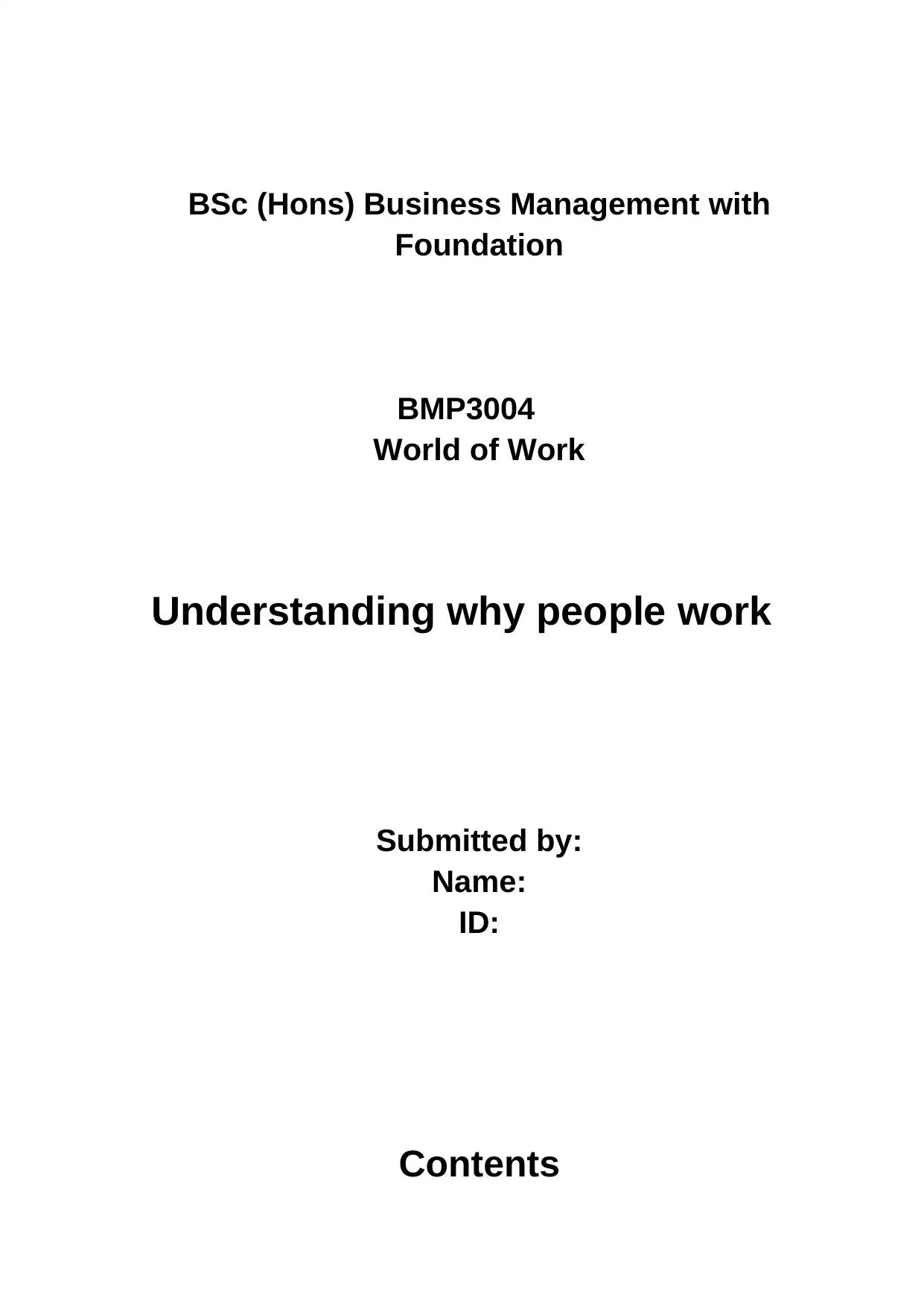
BSc (Hons) Business Management with
Foundation
BMP3004
World of Work
Understanding why people work
Submitted by:
Name:
ID:
Contents
Foundation
BMP3004
World of Work
Understanding why people work
Submitted by:
Name:
ID:
Contents
Paraphrase This Document
Need a fresh take? Get an instant paraphrase of this document with our AI Paraphraser
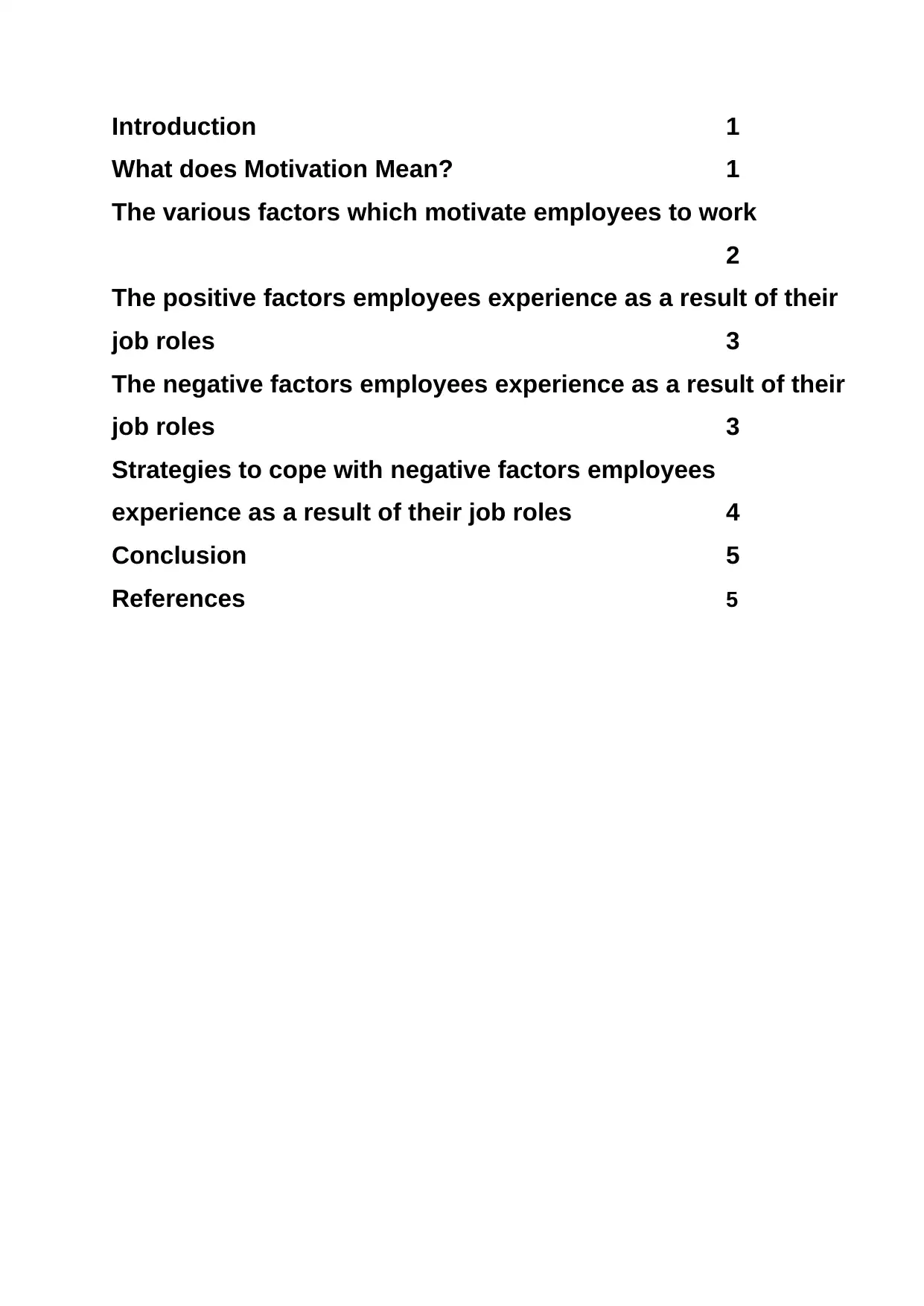
Introduction 1
What does Motivation Mean? 1
The various factors which motivate employees to work
2
The positive factors employees experience as a result of their
job roles 3
The negative factors employees experience as a result of their
job roles 3
Strategies to cope with negative factors employees
experience as a result of their job roles 4
Conclusion 5
References 5
What does Motivation Mean? 1
The various factors which motivate employees to work
2
The positive factors employees experience as a result of their
job roles 3
The negative factors employees experience as a result of their
job roles 3
Strategies to cope with negative factors employees
experience as a result of their job roles 4
Conclusion 5
References 5
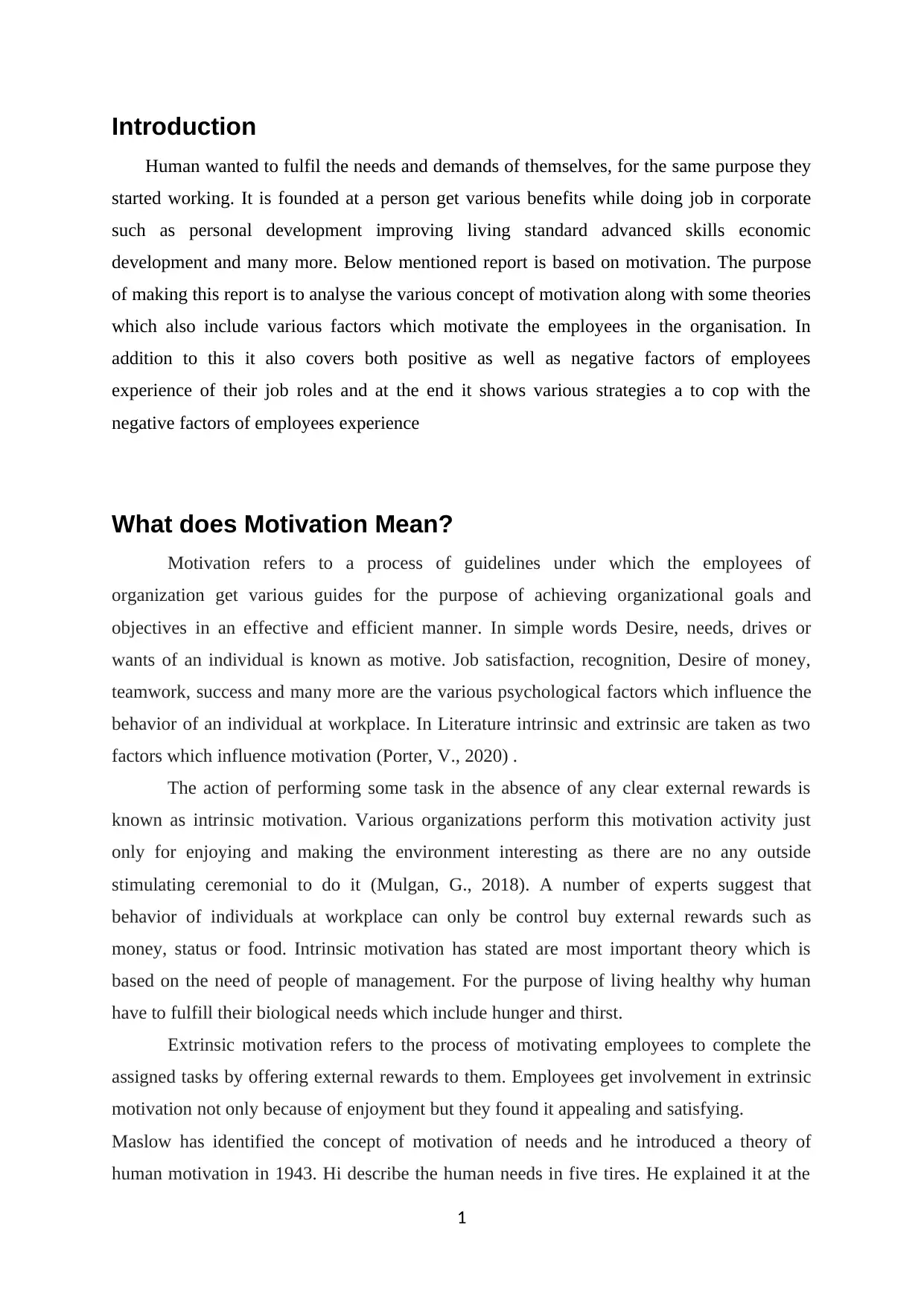
Introduction
Human wanted to fulfil the needs and demands of themselves, for the same purpose they
started working. It is founded at a person get various benefits while doing job in corporate
such as personal development improving living standard advanced skills economic
development and many more. Below mentioned report is based on motivation. The purpose
of making this report is to analyse the various concept of motivation along with some theories
which also include various factors which motivate the employees in the organisation. In
addition to this it also covers both positive as well as negative factors of employees
experience of their job roles and at the end it shows various strategies a to cop with the
negative factors of employees experience
What does Motivation Mean?
Motivation refers to a process of guidelines under which the employees of
organization get various guides for the purpose of achieving organizational goals and
objectives in an effective and efficient manner. In simple words Desire, needs, drives or
wants of an individual is known as motive. Job satisfaction, recognition, Desire of money,
teamwork, success and many more are the various psychological factors which influence the
behavior of an individual at workplace. In Literature intrinsic and extrinsic are taken as two
factors which influence motivation (Porter, V., 2020) .
The action of performing some task in the absence of any clear external rewards is
known as intrinsic motivation. Various organizations perform this motivation activity just
only for enjoying and making the environment interesting as there are no any outside
stimulating ceremonial to do it (Mulgan, G., 2018). A number of experts suggest that
behavior of individuals at workplace can only be control buy external rewards such as
money, status or food. Intrinsic motivation has stated are most important theory which is
based on the need of people of management. For the purpose of living healthy why human
have to fulfill their biological needs which include hunger and thirst.
Extrinsic motivation refers to the process of motivating employees to complete the
assigned tasks by offering external rewards to them. Employees get involvement in extrinsic
motivation not only because of enjoyment but they found it appealing and satisfying.
Maslow has identified the concept of motivation of needs and he introduced a theory of
human motivation in 1943. Hi describe the human needs in five tires. He explained it at the
1
Human wanted to fulfil the needs and demands of themselves, for the same purpose they
started working. It is founded at a person get various benefits while doing job in corporate
such as personal development improving living standard advanced skills economic
development and many more. Below mentioned report is based on motivation. The purpose
of making this report is to analyse the various concept of motivation along with some theories
which also include various factors which motivate the employees in the organisation. In
addition to this it also covers both positive as well as negative factors of employees
experience of their job roles and at the end it shows various strategies a to cop with the
negative factors of employees experience
What does Motivation Mean?
Motivation refers to a process of guidelines under which the employees of
organization get various guides for the purpose of achieving organizational goals and
objectives in an effective and efficient manner. In simple words Desire, needs, drives or
wants of an individual is known as motive. Job satisfaction, recognition, Desire of money,
teamwork, success and many more are the various psychological factors which influence the
behavior of an individual at workplace. In Literature intrinsic and extrinsic are taken as two
factors which influence motivation (Porter, V., 2020) .
The action of performing some task in the absence of any clear external rewards is
known as intrinsic motivation. Various organizations perform this motivation activity just
only for enjoying and making the environment interesting as there are no any outside
stimulating ceremonial to do it (Mulgan, G., 2018). A number of experts suggest that
behavior of individuals at workplace can only be control buy external rewards such as
money, status or food. Intrinsic motivation has stated are most important theory which is
based on the need of people of management. For the purpose of living healthy why human
have to fulfill their biological needs which include hunger and thirst.
Extrinsic motivation refers to the process of motivating employees to complete the
assigned tasks by offering external rewards to them. Employees get involvement in extrinsic
motivation not only because of enjoyment but they found it appealing and satisfying.
Maslow has identified the concept of motivation of needs and he introduced a theory of
human motivation in 1943. Hi describe the human needs in five tires. He explained it at the
1
⊘ This is a preview!⊘
Do you want full access?
Subscribe today to unlock all pages.

Trusted by 1+ million students worldwide

individual go for satisfying the lower level needs first before going for the higher level of
needs. The 5 tires of Maslow Hierarchy of needs theory are explained below in detail:
Psychological needs: the basic requirements of human which are necessary to survive are
psychological needs full stop it include food, shelter, sleep, drink and sex. It is necessary to
fulfill these needs first for human to survive and function perfectly (Liu and et. al., 2020).
Safety needs: after fulfilling the basic needs of human now they want to be safe and Secure
from various factors. Human wanted insipidity involvement order and managing the lives
that's why it becomes a major part of human life. For the purpose of satisfying these needs
human look for police, schools, businesses and medical care.
Love and belonging needs: It is well known that human is a social animal and for surviving
in the society they want interpersonal relationships which motivate their behavior. It includes
receiving and giving affection and love, friendship, trust, affinity and many more (Gilbert, R.
and Gilbert, P., 2017).
Esteem needs: it include Esteem for oneself and desire for reputation or respect from others.
After satisfying love and belonging needs, a human want that the people do respect so that
they can feel reputational at workplace.
Self actualization needs: It refers to the highest level of need stated by Maslow in his
pyramid. As it is the last need of human under which they think about personal growth and
peak experience. When an individual reach at this level they work for achieving everything
that an individual should have.
The various factors which motivate employees to work
Various organizations use several factors for motivating employees. Some of them are
explained below:
Salary: It refers to the basic need of employees. They want to receive continuous payment on
time which provides satisfaction to them towards the work. Getting salary is a short term
factor of satisfaction it result in increasing the performance of employees. Along with this it
also provide a assurance for getting salary rise on time. If the salary of an employee is less it
result in dissatisfaction and disengagement of employees (Rivkin, J. and Ryan, M. eds.,
2017) . The employees will not work effectively which works as a barrier in accomplishing
the goals and objectives.
Promotion: Every employee wants to develop themselves at workplace. Career development
is a important factor for every employee. Promotion helps them in motivating towards the
2
needs. The 5 tires of Maslow Hierarchy of needs theory are explained below in detail:
Psychological needs: the basic requirements of human which are necessary to survive are
psychological needs full stop it include food, shelter, sleep, drink and sex. It is necessary to
fulfill these needs first for human to survive and function perfectly (Liu and et. al., 2020).
Safety needs: after fulfilling the basic needs of human now they want to be safe and Secure
from various factors. Human wanted insipidity involvement order and managing the lives
that's why it becomes a major part of human life. For the purpose of satisfying these needs
human look for police, schools, businesses and medical care.
Love and belonging needs: It is well known that human is a social animal and for surviving
in the society they want interpersonal relationships which motivate their behavior. It includes
receiving and giving affection and love, friendship, trust, affinity and many more (Gilbert, R.
and Gilbert, P., 2017).
Esteem needs: it include Esteem for oneself and desire for reputation or respect from others.
After satisfying love and belonging needs, a human want that the people do respect so that
they can feel reputational at workplace.
Self actualization needs: It refers to the highest level of need stated by Maslow in his
pyramid. As it is the last need of human under which they think about personal growth and
peak experience. When an individual reach at this level they work for achieving everything
that an individual should have.
The various factors which motivate employees to work
Various organizations use several factors for motivating employees. Some of them are
explained below:
Salary: It refers to the basic need of employees. They want to receive continuous payment on
time which provides satisfaction to them towards the work. Getting salary is a short term
factor of satisfaction it result in increasing the performance of employees. Along with this it
also provide a assurance for getting salary rise on time. If the salary of an employee is less it
result in dissatisfaction and disengagement of employees (Rivkin, J. and Ryan, M. eds.,
2017) . The employees will not work effectively which works as a barrier in accomplishing
the goals and objectives.
Promotion: Every employee wants to develop themselves at workplace. Career development
is a important factor for every employee. Promotion helps them in motivating towards the
2
Paraphrase This Document
Need a fresh take? Get an instant paraphrase of this document with our AI Paraphraser

organization. Several of employee’s get motivate by getting opportunities and training to
monetary rewards. Promotion helps the employees in giving their best while performing
various tasks in order to achieve the organizational goals and objectives (Dirlik, A., 2018).
Work Environment: It refers to the environment of workplace in which the employees are
doing business operations. If the employees are motivated towards their work it create a
positive work environment as it provides open space in which employees we look better
while doing work.
The positive factors employees experience as a result of their
job roles
The employees wanted to feel important at workplace as it provide motivation to them.
Success of a business organization is depending on the task which is done by various
employees. So it is necessary to motivate the employees towards the objectives of
organization by using various monetary and non monetary activities of motivation. Below
mentioned are the various positive factors of motivational techniques of employees:
Improve Job Performance: various motivational activities is a motivate employees towards
the goals and objectives of organization which improve the job performance of employees.
Managers of organization do various activities and say thanks to the Employees for offering
the best services to their clients which leads to the increase in the standard of work of
employees (Calef, R., 2018).
Improve job satisfaction: Several motivational activities is a include monetary and non
monetary motivate the employees towards their work. It generates the feeling of
empowerment in the employees so that they can work at high level. It also leads to the
increase in job satisfaction of employees as they feel that they are an important part of
management.
The negative factors employees experience as a result of their
job roles
After analyzing the positive factors of employees experience as a result of the job roles,
it is found that it also have various negative factors. Below mentioned are the various cons of
motivational techniques of employees:
It create conflict at workplace: Motivation is related to the improvement of job performance
but it also generate various issues, tensions and conflicts in the organization. The employees
3
monetary rewards. Promotion helps the employees in giving their best while performing
various tasks in order to achieve the organizational goals and objectives (Dirlik, A., 2018).
Work Environment: It refers to the environment of workplace in which the employees are
doing business operations. If the employees are motivated towards their work it create a
positive work environment as it provides open space in which employees we look better
while doing work.
The positive factors employees experience as a result of their
job roles
The employees wanted to feel important at workplace as it provide motivation to them.
Success of a business organization is depending on the task which is done by various
employees. So it is necessary to motivate the employees towards the objectives of
organization by using various monetary and non monetary activities of motivation. Below
mentioned are the various positive factors of motivational techniques of employees:
Improve Job Performance: various motivational activities is a motivate employees towards
the goals and objectives of organization which improve the job performance of employees.
Managers of organization do various activities and say thanks to the Employees for offering
the best services to their clients which leads to the increase in the standard of work of
employees (Calef, R., 2018).
Improve job satisfaction: Several motivational activities is a include monetary and non
monetary motivate the employees towards their work. It generates the feeling of
empowerment in the employees so that they can work at high level. It also leads to the
increase in job satisfaction of employees as they feel that they are an important part of
management.
The negative factors employees experience as a result of their
job roles
After analyzing the positive factors of employees experience as a result of the job roles,
it is found that it also have various negative factors. Below mentioned are the various cons of
motivational techniques of employees:
It create conflict at workplace: Motivation is related to the improvement of job performance
but it also generate various issues, tensions and conflicts in the organization. The employees
3
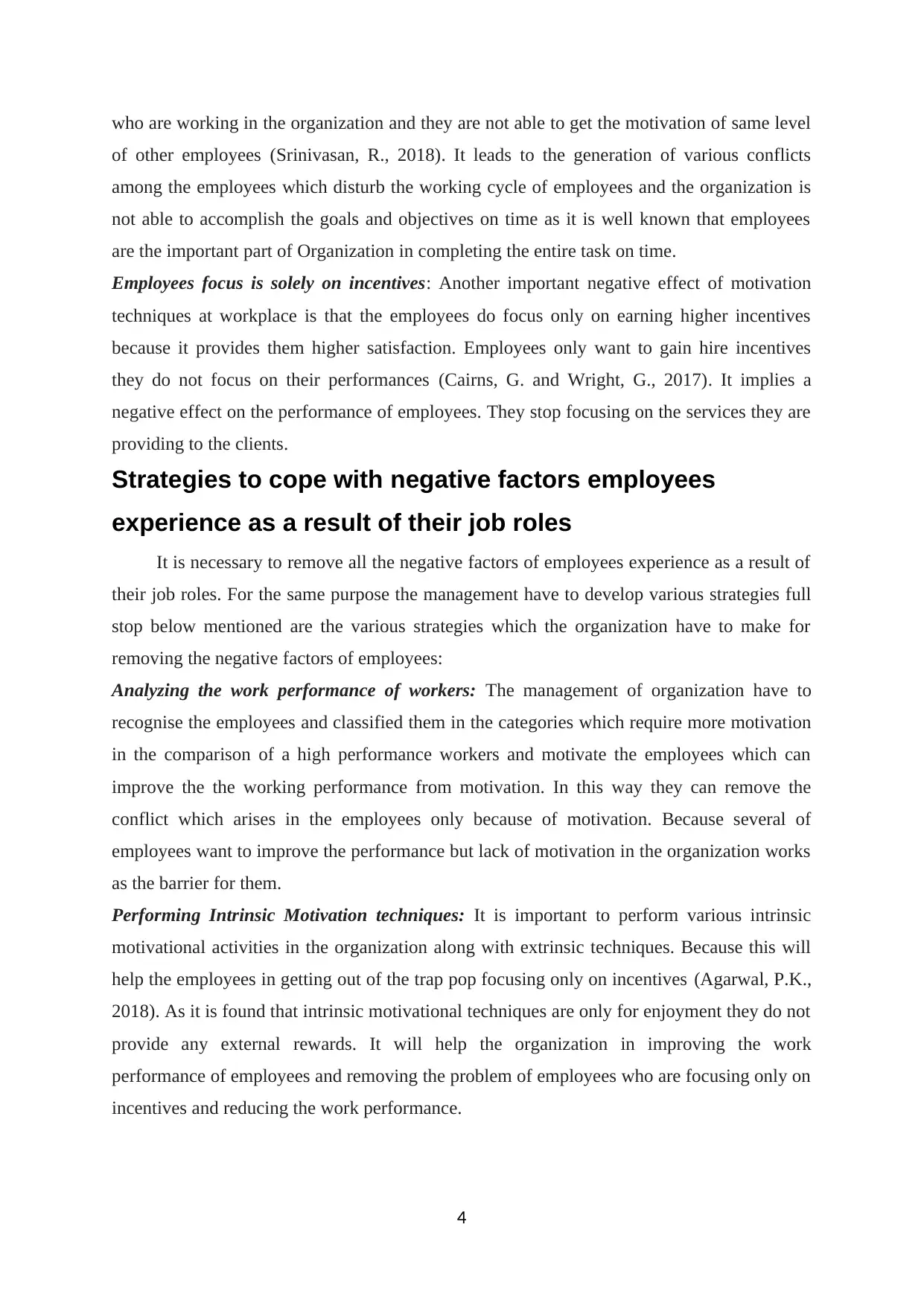
who are working in the organization and they are not able to get the motivation of same level
of other employees (Srinivasan, R., 2018). It leads to the generation of various conflicts
among the employees which disturb the working cycle of employees and the organization is
not able to accomplish the goals and objectives on time as it is well known that employees
are the important part of Organization in completing the entire task on time.
Employees focus is solely on incentives: Another important negative effect of motivation
techniques at workplace is that the employees do focus only on earning higher incentives
because it provides them higher satisfaction. Employees only want to gain hire incentives
they do not focus on their performances (Cairns, G. and Wright, G., 2017). It implies a
negative effect on the performance of employees. They stop focusing on the services they are
providing to the clients.
Strategies to cope with negative factors employees
experience as a result of their job roles
It is necessary to remove all the negative factors of employees experience as a result of
their job roles. For the same purpose the management have to develop various strategies full
stop below mentioned are the various strategies which the organization have to make for
removing the negative factors of employees:
Analyzing the work performance of workers: The management of organization have to
recognise the employees and classified them in the categories which require more motivation
in the comparison of a high performance workers and motivate the employees which can
improve the the working performance from motivation. In this way they can remove the
conflict which arises in the employees only because of motivation. Because several of
employees want to improve the performance but lack of motivation in the organization works
as the barrier for them.
Performing Intrinsic Motivation techniques: It is important to perform various intrinsic
motivational activities in the organization along with extrinsic techniques. Because this will
help the employees in getting out of the trap pop focusing only on incentives (Agarwal, P.K.,
2018). As it is found that intrinsic motivational techniques are only for enjoyment they do not
provide any external rewards. It will help the organization in improving the work
performance of employees and removing the problem of employees who are focusing only on
incentives and reducing the work performance.
4
of other employees (Srinivasan, R., 2018). It leads to the generation of various conflicts
among the employees which disturb the working cycle of employees and the organization is
not able to accomplish the goals and objectives on time as it is well known that employees
are the important part of Organization in completing the entire task on time.
Employees focus is solely on incentives: Another important negative effect of motivation
techniques at workplace is that the employees do focus only on earning higher incentives
because it provides them higher satisfaction. Employees only want to gain hire incentives
they do not focus on their performances (Cairns, G. and Wright, G., 2017). It implies a
negative effect on the performance of employees. They stop focusing on the services they are
providing to the clients.
Strategies to cope with negative factors employees
experience as a result of their job roles
It is necessary to remove all the negative factors of employees experience as a result of
their job roles. For the same purpose the management have to develop various strategies full
stop below mentioned are the various strategies which the organization have to make for
removing the negative factors of employees:
Analyzing the work performance of workers: The management of organization have to
recognise the employees and classified them in the categories which require more motivation
in the comparison of a high performance workers and motivate the employees which can
improve the the working performance from motivation. In this way they can remove the
conflict which arises in the employees only because of motivation. Because several of
employees want to improve the performance but lack of motivation in the organization works
as the barrier for them.
Performing Intrinsic Motivation techniques: It is important to perform various intrinsic
motivational activities in the organization along with extrinsic techniques. Because this will
help the employees in getting out of the trap pop focusing only on incentives (Agarwal, P.K.,
2018). As it is found that intrinsic motivational techniques are only for enjoyment they do not
provide any external rewards. It will help the organization in improving the work
performance of employees and removing the problem of employees who are focusing only on
incentives and reducing the work performance.
4
⊘ This is a preview!⊘
Do you want full access?
Subscribe today to unlock all pages.

Trusted by 1+ million students worldwide
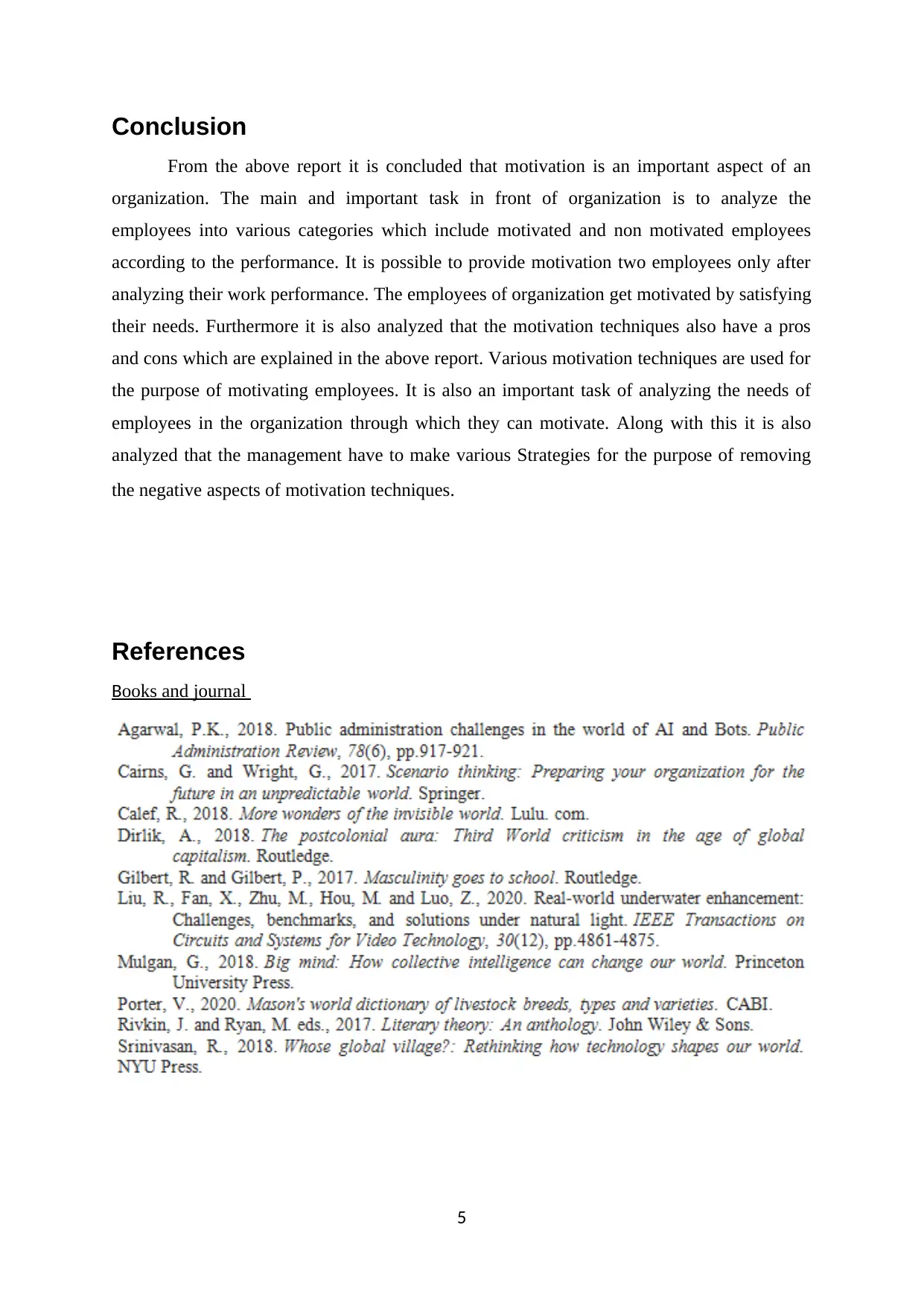
Conclusion
From the above report it is concluded that motivation is an important aspect of an
organization. The main and important task in front of organization is to analyze the
employees into various categories which include motivated and non motivated employees
according to the performance. It is possible to provide motivation two employees only after
analyzing their work performance. The employees of organization get motivated by satisfying
their needs. Furthermore it is also analyzed that the motivation techniques also have a pros
and cons which are explained in the above report. Various motivation techniques are used for
the purpose of motivating employees. It is also an important task of analyzing the needs of
employees in the organization through which they can motivate. Along with this it is also
analyzed that the management have to make various Strategies for the purpose of removing
the negative aspects of motivation techniques.
References
Books and journal
5
From the above report it is concluded that motivation is an important aspect of an
organization. The main and important task in front of organization is to analyze the
employees into various categories which include motivated and non motivated employees
according to the performance. It is possible to provide motivation two employees only after
analyzing their work performance. The employees of organization get motivated by satisfying
their needs. Furthermore it is also analyzed that the motivation techniques also have a pros
and cons which are explained in the above report. Various motivation techniques are used for
the purpose of motivating employees. It is also an important task of analyzing the needs of
employees in the organization through which they can motivate. Along with this it is also
analyzed that the management have to make various Strategies for the purpose of removing
the negative aspects of motivation techniques.
References
Books and journal
5
1 out of 7
Related Documents
Your All-in-One AI-Powered Toolkit for Academic Success.
+13062052269
info@desklib.com
Available 24*7 on WhatsApp / Email
![[object Object]](/_next/static/media/star-bottom.7253800d.svg)
Unlock your academic potential
Copyright © 2020–2025 A2Z Services. All Rights Reserved. Developed and managed by ZUCOL.



